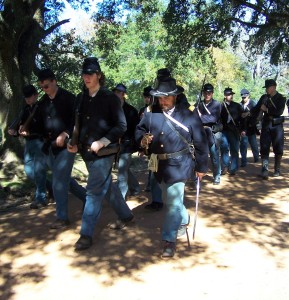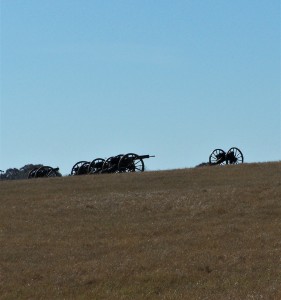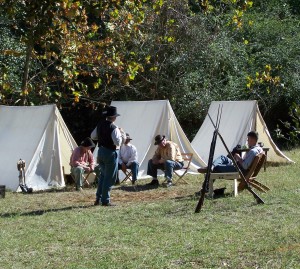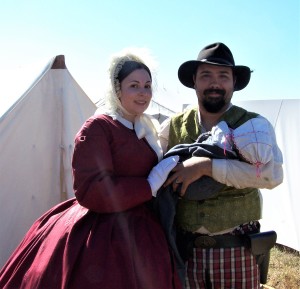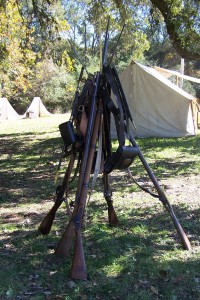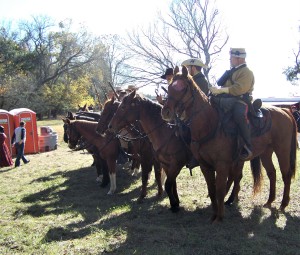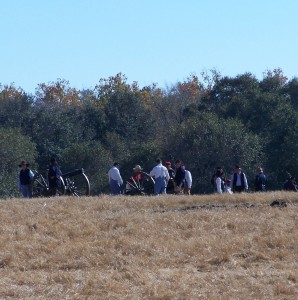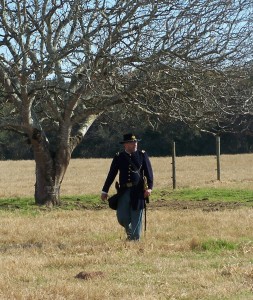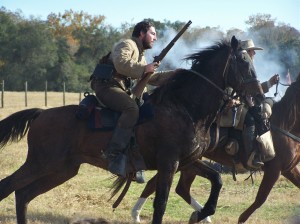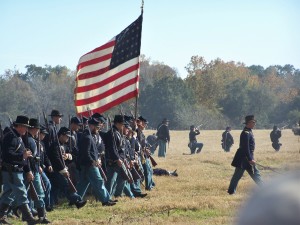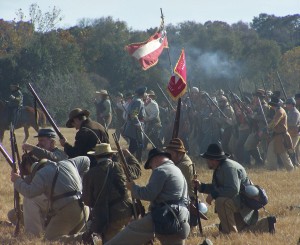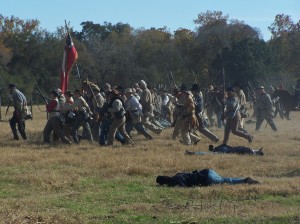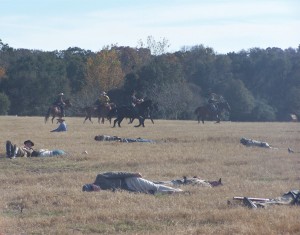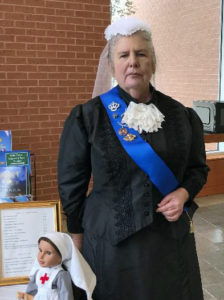(Minerva “Minnie” Vining, a spinster of independent means, is visiting relatives in Richmond, Virginia, in the early 1850ies)
On her return to the Edmonds house, the maid who opened the door for her whispered,
“Ma’am is in de parlor with Ma’am Vining an’ de girls, Miss Minerva…â€
Susan called from the parlor, obviously having heard the bell, and the door open and shut. “Minnie, is that you, dear? You must join us – Mrs. Van Lew just sent a boy with a note saying that she and Miss Elizabeth would be here momentarily …â€
“Allow me to change my dress, Sue,†Minnie replied, and hastened up the stairs to the room that she and Annabelle shared, to discover that someone – either Annabelle or one of Susan’s housemaids had already laid out one of her afternoon dresses; a simple gown in the s pale violent of half-morning, with a lacy fichu – all with the creases from having been packed in a trunk neatly pressed out by the unseen hands of Cousin Susan’s Negro maids. Minnie hastily unbuttoned the skirt and bodice of her walking costume and exchanged her stockings and high-buttoned boots and for clean white stockings and plain dainty slippers. By the time she had effected this change, and hurried downstairs, the maid was already opening the front door to admit two ladies. Minnie fairly scampered into the parlor, and settled onto the divan next to Annabelle, who whispered,
“You’re late! We were beginning to despair! Did you lose track of the time?â€
“The gardens of Church Hill are so splendid,†Minnie gasped. “I confess that I did – I am sorry, Susan – I was admiring certain of the trees; those with white flowers, of four or five petals.â€
“Dogwood trees,†Charlotte piped up, and Susan chided her.
“Dear, speak when you are spoken to. Yes, the dogwood trees are particularly splendid this spring, although you have missed the jonquils at their best. But the magnolias are soon to bloom…Yes, Sadie?†That last was addressed to the maid, deferential in her dark dress, white apron and turban, lingering in the doorway.
“Mrs. Eliza Van Lew, Miss Elizabeth, Ma’am,†she murmured, and stepped aside from the doorway as Susan rose from her chair.
“Eliza, my dear!†she exclaimed to the older lady; a pleasant-faced matron with pink cheeks and very white hair, dressed as modestly as a Quaker in a grey walking dress bereft of any additional adornments. “And Lizzie – we are so pleased to see you today! Come in, come in! I must introduce you to my cousins, visiting from Boston: Mrs. Annabelle Vining, and Miss Minerva Vining – they have come to celebrate Lydia’s marriage with us and then to stay the summer over … the gentlemen will join us shortly.†Susan and the Van Lew ladies exchanged brief social embraces – the older lady with more open affection than the younger. “They traveled by train, all of the way,†Susan added, and the Van Lew ladies chorused their wonder and approval.
“From Boston!†Exclaimed Eliza Van Lew, as she turned her attention towards Minnie and Annabelle. “And on the train – what a marvel the railway has become. Now, I was brought up in Philadelphia, and my daughter attended school there, and now the matter of travel has become so much less onerous than it once was … how welcome you are to Richmond!â€
“We have been received with every fond courtesy,†Annabelle replied, while – unobserved – Minnie regarded Miss Lizzie Van Lew, recognizing as if with a secret Masonic handshake, another stubborn spinster of her ilk. Yes, Miss Elizabeth was pleasing in her aspect and person, and fashionably-clad; a perfect blonde rose of the South, with the flaxen hair, unearthly blue eyes, and that fine complexion lauded by every sentimental novelist and fashion-paper … and yet, Miss Van Lew defied that convention, for her nose was a perfect beak and those eyes reflected a piercing and unsettling intelligence.
“Miss Vining,†she said, and her voice was pleasant and cultured. “May I sit with you and converse? I would adore to hear of how the abolitionist cause is progressing in the North. We hear so very little of the matter here in Richmond, you see – only fulminations against such wicked persuaders such as your Mr. Garrison, and the Reverend Slocomb – since he is of Boston, may I presume that you are acquainted with him?â€
“But certainly,†Minnie answered, pleased and heartened at encountering a kindred spirit among Susan’s circle. “Mr. Garrison was a particular friend of my late brother, although they had fallen out over … some aspect of campaigning for the cause of abolition. I cannot recall the specific issue as Mr. Garrison is a passionate advocate and not easily brought to compromise. But he and my brother did eventually reconcile. Reverend Slocomb ministers to the congregation which I attend – and I have the privilege of a personal acquaintance with him, as well as a personally-inscribed volume of his sermons …â€
“Indeed, I have a copy of that very same book!†Miss Lizzie beamed, radiantly, and Minnie laughed.
“I am reassured in making your acquaintance, Miss Van Lew – I had become convinced that such abolitionist sentiments are most rare in the South,â€
“Alas, they are,†Lizzie Van Lew agreed, without rancor. “But I care little, nor does Mama, or my brother John. Among our circle of friends, it is considered – so far – merely an eccentricity peculiar to the Quakers of the northern States, and thus tolerated. My late father left us so considerable an estate as to shelter us well against that public opprobrium which might fall upon those of lesser means, otherwise …â€
At that moment in their conversation, Richard and Cousin Peter joined what had become a most pleasant gathering: Susan fussed over settling her father into the most comfortable chair, and Richard took a seat on one of the spindly parlor chairs opposite the divan where Annabelle sat with Minnie and Miss Van Lew. No sooner was the introduction made, than Susan’s maid announced the arrival of another party.
“Captain and Mrs. Shaw, and Mr. Devereaux, Ma’am,†the girl said, and suddenly it seemed that Susan’s parlor was very full, although a large portion of that came from Mrs. Shaw’s fashionable crinoline as she leaned on her husbands’ arm, and the breadth of shoulder of the man who followed the pair into the parlor. Minnie couldn’t help that her eyes were drawn to him, as if by a magnet; tall and fair-haired, with rugged sun-bronzed features and eyes of a particular pale blue hue, a specimen of vigorous maturity, whom she judged to be about the age of her own. He possessed the same arresting quality as the Reverend Slocomb – that of an actor commanding the attention of an audience as he strode the boards.
“Why, Miss Elizabeth!†he exclaimed, in a gentle drawl which Minnie had begun to identify as that trait of those from the deeper south. “You mus’ do me the honor of acquainting me with your charming friends!â€
Elizabeth appeared entirely unmoved by his courteous regard, even though it drew the interest of the other women in the room as a sunflower follows the sun. “These ladies are Mrs. Edmonds’ Boston relations,†she replied, in a voice devoid of the least scrap of flirtatious interest. “Miss Minerva and Mrs. Annabelle Vining. This gentleman is Preston Devereaux, lately returned from … where was it? I heard that it was traveling abroad; I cared little for where, although I prayed that it be far, far from Richmond…â€
“My dear lady Tongue,†Preston Devereaux returned, seemingly much amused. “I thank you for your courtesy, Miss Elizabeth of Kate Hall. Ladies …†he kissed Annabelle’s raised hand, and then Minnies’, “Consider me to be at your most devoted service!â€
Minnie and Annabelle briefly met each other’s eyes.
A rogue, indeed, was Annabelle’s unvoiced comment.
Yes, but an amusing one, Minnie signaled.
“I deduce from your manner of speech that you are from another place than this,†Minnie ventured, for yes, Preston Devereaux’s accent was the most deeply marked in Southern inflection that she had heard thus far.
“Charleston, Miss Vining,†he replied, with a smile which drew her – although not as deeply as it would have, if she had been as young as Charlotte Edmonds. “My family there is said to be descended from a latter sprout on the family tree of that Robert Deveraux, once the Earl of Essex and favorite of Good Queen Bess.â€
“Charleston,†remarked Captain Shaw, from across the parlor where he had taken a seat next to Cousin Peter. Captain Shaw was dark of hair and yet had the same pale blue eyes as his cousin. His young wife was deep in converse with the Eliza Van Lew. “Where it is often said that the inhabitants most resemble the heathen Chinee – in that all eat rice and worship their ancestors.â€
That bon mot earned a ripple of amused laughter from the ladies within hearing, and a chuckle from Preston Devereaux, who appeared to take no offense, as he regarded the three ladies – Miss Elizabeth, Annabelle and Minnie.
“I trust that you are finding your visit to Richmond enjoyable?†Preston Devereaux inquired, as if he really were interested, and Minnie replied,
“We have only been here for a day, Mr. Devereaux, but we have been warmly welcomed by our kin, and friends such as Miss Van Lew…â€
“Richmond is so very different from Boston,†Annabelle echoed, and Miss Elizabeth set aside her teacup.
“We were having the most interesting talk,†she remarked, as every word were a little dagger. “Regarding mutual friends, and an interest in abolition.â€
Minnie exchanged a glance with Annabelle; for all the care taken in leaving certain topics of conversation unexplored in the interests of civility among friends and kin, Miss Elizabeth was treading heavily among the conversational caltrops.
“Indeed,†Preston Devereaux raised an eyebrow. “A fascinating topic, Miss Elizabeth – alas, not one of interest to me: I may truly boast of having not a single drop of abolition blood in me.â€
“A pity,†Miss Elizabeth observed, acidly “For I daresay that a single drop would make you into a man, rather than your present nonentity.â€
Minnie drew in her breath with a horrified gasp, fully expecting Preston Devereaux to react as any ordinary man who had been insulted by a lady in the confines of another lady’s parlor, but instead, he merely chuckled appreciatively.
“Touché, Miss Elizabeth – my dearest shrew. I did invite that hit! Miss Vining pray do not look as if you meant to take offense on my part. Miss Van Lew and I have been in the habit of verbal jousts such as this for years. Such bouts sharpen our relative wits and amuse our friends no end.â€
“Be warned concerning Mr. Devereaux’s conversation,†Miss Elizabeth returned, with an air of stark warning. “He assumes attitudes not from any deep conviction, but merely from a desire to provoke and tease. He is a veritable whirligig, turning as the conversational wind blows.â€
“I have heard that Mr. Devereaux was abroad on foreign travels,†Annabelle interjected, in a manner intended to be placating, and that gentleman smiled as if he divined her motivation and was prepared to be indulgent of it. “I would like so very much to hear of his adventures – our cousin Susan says that you sought gold in California! So very exciting! What was it like? One hears the most fascinating tales of adventures and riches to be had in the mines. And now California is to be a state, so soon after having been merely a foreign possession! The gold mines are of an incredible richness, we hear tell.â€
“I was in China, on an errand of some import for a relative of mine, and on my return, the ship on which I was traveling made port in California … and the news of the discovery of gold caused all of the sailors to desert,†Mr. Devereaux accepted a cup of tea and a plate of cake from Susan’s silent housemaids. Minnie made a private memorandum to herself; make sufficient conversation with Susan’s household slaves to learn their names. It seemed untoward to not know the names of servants, or not even to be able to tell them apart, so alike they all appeared, in their anonymous dark dresses and dark faces, below snowy-white turbans, as if interchangeable human automatons, given into service. Mr. Devereaux continued.
“We were there becalmed, in the port of Yerba Buena – although now it is called San Francisco. Situated on the most marvelous sheltered bay. The word came that gold had been discovered in the foothills of that mountain-range which shelters California to the east … even, that discovery was shouted in the streets, with proof brandished by one of the most respected men of town … I vow that even the few soldiers of the Presidio deserted their posts! All were maddened by the possibility of gold to be had, as easily as you ladies might pluck up and gather flowers from your gardens…â€
“And did you find any gold yourself, in those bounteous California mines?†Miss Elizabeth sounded most skeptical, as Lizzie and Annabelle hung on every word. Minnie noted that Mrs. Eliza was deep in conversation with the young Mrs. Shaw – ah, from Philadelphia, she recollected. They must have interests, if not kin in common. Richard and Cousin Peter were likewise deep in converse together with Captain Shaw – matters of military import, both recent and of a historic nature, Minnie assumed. Charlotte and Lydia appeared likewise engaged in a converse most intense with a slender young gentleman who had also been announced. Minnie gathered that he was Lydia’s intended, from the fond manner in which Susan made him welcome to the parlor. She would have been more interested in the lad – but for being fascinated in the tale which Pres Devereaux had to tell.


